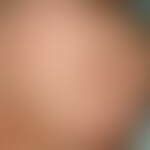Synonym(s)
DefinitionThis section has been translated automatically.
Group of rare, autosomal recessive inherited congenital ichthyosiform cornification disorders, which usually persist throughout life and are often associated with an allergic tendency and pruritus. In the affected persons the stratum corneum repeatedly detaches spontaneously and unevenly.
ClassificationThis section has been translated automatically.
5 clinical pictures are distinguished - Peeling Skin Syndrome A-E.
- Peeling skin syndrome 1 (OMIM:616265): generalized, non-inflammatory clinical picture; development of symptoms only in the 4th-7th year of life. Genetic defect not yet confirmed (mutations in the CHST8 gene (19q13.11), which codes for the carbohydrate sulfotransferase 8, have been detected).
- Peeling skin syndrome 2 (270300): generalized inflammatory (erythrodermic) clinical picture, development of symptoms immediately after birth. Mutation in the CDSN gene, which encodes corneodesmosin. By definition, peeling skin syndrome B is called "peeling skin disease ".
- Peeling skin syndrome 3 (OMIM:270300): Acral peeling skin syndrome, with circumscribed keratolysis, also blistering on dorsum of hands and feet. It is caused by various mutations of the TGM5 gene. Mutations of the TGM5 gene which codes for transglutaminase 5. This clinical picture is now classified as subprabasal epidermolysis bullosa simplex (see below hereditary epidermolyses ).
- Exfoliative ichthyosis:
- Peeling skin syndromes 4 and 5 (PSSA4/5): Exfoliative ichthyosis with dry skin and an aqua-sensitive, macerative palmoplantar keratosis (phenomenon of "washerwoman's hands" on contact with water): Underlying mutations in the genes of cystatin A (CSTA) and serpin B8 (PSS5).
You might also be interested in
EtiopathogenesisThis section has been translated automatically.
In inflammatory peeling skin syndrome 2, various "loss of function" mutations of the corneodesmosin gene (CDSN) are detectable. This gene is located on chromosome 6p21. It codes for the protein corneodesmosin (CDSN). The autosomal recessive mutation causes this important adhesion protein to be incompletely expressed or completely absent in the entire body skin of an affected person. This results in skin barrier disorders with itching, urticaria, asthma and food allergies. At the same time: IgE increased, blood eosinophilia.
In the late-manifesting (occurring after the age of 1) non-inflammatory peeling skin syndrome 1, the genetic defect has not yet been confirmed (CHST-8 gene = gene for carbohydrate sulfotransferase 8). Those affected show a pronounced tendency to painless superficial peeling of the skin over the entire skin. The associated symptoms of type B are absent.
In peeling skin syndrome 3, acral peeling skin syndrome, the transformation of transglutaminase 5 leads to circumscribed superficial keratolysis on the backs of the hands and feet.
In peeling skin syndrome 4 (PSS4; OMIM: 607936), an autosomal recessive genodermatosis, the skin changes that become apparent shortly after birth resemble superficial epidermolytic ichthyosis. The aquasensitive palmoplantar keratoses are clinically prominent. The underlying cause is mutations in the cystatin A gene.
In peeling skin syndrome 5 (PSS5), skin changes analogous to PSS4 are found. Mutations in the serpin B8 gene are present. The gene codes for the serpin B8 protein. This protein plays an important role in the formation of desmosomes and thus in cell-cell adhesion.
ClinicThis section has been translated automatically.
In generalized types 1 (non-inflammatory late manifestations) and 2 (inflammatory, congenital) there are itching or burning, peripherally migrating erythema with Collerette-like scaling. The psoriatic border can easily be removed in a parchment-like manner.
HistologyThis section has been translated automatically.
Peeling skin syndrome 2: psoriasiform epidermal reaction with hyperkeratosis, focal parakeratosis, sparse round cell infiltrates in the corium, separation of the stratum corneum above the epithelial layer. In some cases the stratum corneum is completely absent. Electron microscopy: Absence of normal keratohyalin.
Types 1 and 3 show only a detachment of the horny layer without inflammatory changes.
Differential diagnosisThis section has been translated automatically.
Clinical:
- Netherton syndrome (hair shaft anomalies - bamboo hair)
- Atopic dermatitis (other signs of atopy)
- Post-inflammatory desquamation (after previous inflammatory skin diseases)
- Other aquasensitive palmoplantar keratoses (see below aquagenic palmoplantar keratoderma)
Histologically:
- Psoriasis (with typical expression evidence of Munro microabscesses)
Note(s)This section has been translated automatically.
Corneodesmosin (see below CDSN gene) is an important binding molecule of the epidermis that binds corneocytes together and builds up molecular junctions of the horny layer(corneodesmosomes). This results in barrier disorders of the skin. This makes it easier for pathogens or allergens to penetrate the skin.
LiteratureThis section has been translated automatically.
- Benchat L et al (2014) Acral peeling skin syndrome]. Ann Dermatol Venereol 141:316-318.
- Hashimoto K et al (2000) Acral peeling skin syndrome. J Am Acad Dermatol 43: 1112-1119.
- Kawakami H et al. (2014) A Case of Inflammatory Generalized Type of Peeling Skin Syndrome Possibly Caused by a
- Homozygous Missense Mutation of CDSN. Case Rep Dermatol 6:232-238
- Meovrah B et al (1987) Peeling skin syndrome: aclinical, ultrastructural and biochemical study. Br J Dermatol 116: 117-125.
- Oji V et al (2010) Loss of corneodesmosin Leads to Severe Skin Barrier Defect, Pruritus, and Atopy: Unraveling the Peeling Skin Disease. AJHG 87: 274-281
- Valentin Fet al (2021) Development of a pathogenesis-based therapy for peeling skin syndrome type 1. Br J Dermatol 84: 1123-1131.
- van der Velden JJAJ et al (2020) Mutations in the CDSN gene cause peeling skin disease and hypotrichosis simplex of the scalp. J Dermatol 47:3-7.
- Vincent O et al (2010) Peeling skin disease: elucidation of a rare genetic keratinization disorder. JDDG 8: 941
Incoming links (8)
CDSN Gene; Congenital ichthyosiform erythroderma; COVID-19 and skin; CSTA Gene; Exfoliative keratolysis congenita; Netherton syndrome; Palmoplantar keratosis aquagene diffuse non-epidermolytic (type bothnian); SERPINB8 Gene;Outgoing links (14)
Acral peeling skin syndrome; Aquagene palmoplantar keratoderma; CDSN Gene; CHST8 Gene; CSTA Gene; Dermis; Desmosomes; Epidermolysis bullosa hereditaria (overview); Hyperkeratoses; Netherton syndrome; ... Show allDisclaimer
Please ask your physician for a reliable diagnosis. This website is only meant as a reference.










